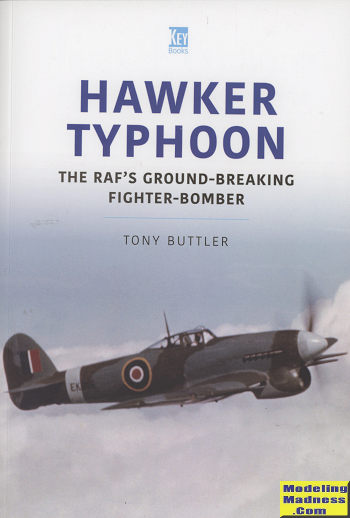 Development of
the Typhoon started before the start of WWII. It was to be a replacement fighter
for the Hurricane and so, to hedge their bets, there were two nearly idential
types started, each with a different engine. The Typhoon was powered by the
Napier Sabre while the Tornado was to be powered by a Rolls Royce Vulture. The
Vulture was already powering the Manchester bomber but was fraught with
difficulties and just did not turn out to be a reliable engine. Not that it was
all roses for the Sabre as it had its usual teething issues. Development was not
helped with all work on both planes was halted in 1940 in order to concentrate
on building extant types.
Development of
the Typhoon started before the start of WWII. It was to be a replacement fighter
for the Hurricane and so, to hedge their bets, there were two nearly idential
types started, each with a different engine. The Typhoon was powered by the
Napier Sabre while the Tornado was to be powered by a Rolls Royce Vulture. The
Vulture was already powering the Manchester bomber but was fraught with
difficulties and just did not turn out to be a reliable engine. Not that it was
all roses for the Sabre as it had its usual teething issues. Development was not
helped with all work on both planes was halted in 1940 in order to concentrate
on building extant types.
Though work on the Typhoon eventually started back, the
Tornado was soon seen as a dead end and work quit in 1941 after one production
aircraft came off the line. The prototypes and production plane were then used
mostly as engine test beds with one converted to the Centaurus radial engine
used for development for the Tempest II.
Thanks to the Typhoon's thick wing, it was a stable gun
platform and was strong enough to handle underwing rocket projectiles. It also
allowed the aircraft to have a fairly high diving speed, something that came in
handy. It also meant that the plane, while fast, was not the greatest dog
fighter. After a period of time tackling German fighter bombers, Typhoons
gradually were devoted to a task in which they exceeded, and that is ground
attack. while not the 'rocket carrying tank buster' about which one often reads,
their heavy 20mm armament was quite effective as was their ability to carry up
to 1,000 lb bombs under each wing. As such, when the ground fighting moved to
the continent, they made up the majority of units operating with the 2nd TAF.
With the follow-on Tempest being an even better fighter, the Typhoon quickly
disappeared once the war was over.
In this book, the author covers the development,
deployment, and changes in the airframe. Quite a bit is provided on its
operational service. This is also a photo book with lots of period photos, some
of them in color. It is well done and
informative, which is what I think most people are looking for. As such, the
book is very much recommended to you.
July 2022
Copyright ModelingMadness.com. All rights reserved. No
reproduction in part or in whole without express permission.
Review book courtesy of
Casemate Publishing.
You can get yours today
from this link.
If you would like your product reviewed fairly and quickly, please
contact
me or see other details in the
Note to
Contributors.
 Development of
the Typhoon started before the start of WWII. It was to be a replacement fighter
for the Hurricane and so, to hedge their bets, there were two nearly idential
types started, each with a different engine. The Typhoon was powered by the
Napier Sabre while the Tornado was to be powered by a Rolls Royce Vulture. The
Vulture was already powering the Manchester bomber but was fraught with
difficulties and just did not turn out to be a reliable engine. Not that it was
all roses for the Sabre as it had its usual teething issues. Development was not
helped with all work on both planes was halted in 1940 in order to concentrate
on building extant types.
Development of
the Typhoon started before the start of WWII. It was to be a replacement fighter
for the Hurricane and so, to hedge their bets, there were two nearly idential
types started, each with a different engine. The Typhoon was powered by the
Napier Sabre while the Tornado was to be powered by a Rolls Royce Vulture. The
Vulture was already powering the Manchester bomber but was fraught with
difficulties and just did not turn out to be a reliable engine. Not that it was
all roses for the Sabre as it had its usual teething issues. Development was not
helped with all work on both planes was halted in 1940 in order to concentrate
on building extant types.